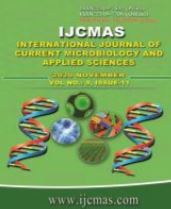


 National Academy of Agricultural Sciences (NAAS)
National Academy of Agricultural Sciences (NAAS)

|
PRINT ISSN : 2319-7692
Online ISSN : 2319-7706 Issues : 12 per year Publisher : Excellent Publishers Email : editorijcmas@gmail.com / submit@ijcmas.com Editor-in-chief: Dr.M.Prakash Index Copernicus ICV 2018: 95.39 NAAS RATING 2020: 5.38 |
Land surface temperature (LST) is an important factor in many areas, such as global climate change, hydrological, geo-biophysical and urban land use / land cover. As the latest satellite launched from the Landsat family, LANDSAT-8 has opened new possibilities for understanding the events on the Earth with remote sensing. In this study, an attempted has been made to estimate land surface temperature for Nainital District of Uttarakhand, India. Nainital is a tourist place which attracts thousands of tourists every year, but now the area has been affected by global warming and increasing temperature. To estimation of LST, Landsat-8 imagery series has been used in the study from 2013 – 2019. LST has been calculated based on NDVI algorithm. After calculation of percentage area in different land surface temperature range, the average temperature of the studied area also determined in QGIS Software. For this purpose Plug-in of QGIS has been used. The minimum average temperature has been observed 8.1129 Kelvin in year 2016 and maximum average land surface area temperature 9.5902 Kelvin has been determined in the year 2019. In last the trend has been calculated in temperature based on linear regression method and Mann-Kendall test. Both test shows increasing trend in temperature. But based on Mann-Kendall test the trend is not significant at 1% and 5% level of significance. That mean the temperature in the studied period has been increased but not in sufficiency. For future studies, the tool is very helpful and should be refined with in situ measurements of LST.
 |
 |
 |
 |
 |